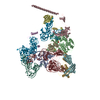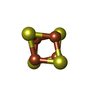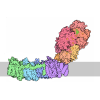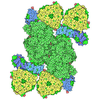[English] 日本語
 Yorodumi
Yorodumi- PDB-3j16: Models of ribosome-bound Dom34p and Rli1p and their ribosomal bin... -
+ Open data
Open data
- Basic information
Basic information
| Entry | Database: PDB / ID: 3j16 | ||||||
|---|---|---|---|---|---|---|---|
| Title | Models of ribosome-bound Dom34p and Rli1p and their ribosomal binding partners | ||||||
 Components Components |
| ||||||
 Keywords Keywords | RIBOSOME / ribosome recycling / translation / eukarya | ||||||
| Function / homology |  Function and homology information Function and homology informationRNA surveillance / Dom34-Hbs1 complex / nuclear-transcribed mRNA catabolic process, no-go decay / nuclear-transcribed mRNA catabolic process, non-stop decay / ribosome disassembly / mTORC1-mediated signalling / Formation of the ternary complex, and subsequently, the 43S complex / Translation initiation complex formation / Ribosomal scanning and start codon recognition / nonfunctional rRNA decay ...RNA surveillance / Dom34-Hbs1 complex / nuclear-transcribed mRNA catabolic process, no-go decay / nuclear-transcribed mRNA catabolic process, non-stop decay / ribosome disassembly / mTORC1-mediated signalling / Formation of the ternary complex, and subsequently, the 43S complex / Translation initiation complex formation / Ribosomal scanning and start codon recognition / nonfunctional rRNA decay / Major pathway of rRNA processing in the nucleolus and cytosol / SRP-dependent cotranslational protein targeting to membrane / GTP hydrolysis and joining of the 60S ribosomal subunit / Nonsense Mediated Decay (NMD) independent of the Exon Junction Complex (EJC) / Nonsense Mediated Decay (NMD) enhanced by the Exon Junction Complex (EJC) / Formation of a pool of free 40S subunits / L13a-mediated translational silencing of Ceruloplasmin expression / positive regulation of translational initiation / ribosomal small subunit binding / 90S preribosome / ribosomal subunit export from nucleus / translational termination / translation initiation factor activity / rescue of stalled ribosome / RNA endonuclease activity / ribosomal large subunit biogenesis / positive regulation of translation / maturation of SSU-rRNA from tricistronic rRNA transcript (SSU-rRNA, 5.8S rRNA, LSU-rRNA) / meiotic cell cycle / translational initiation / small-subunit processome / cytoplasmic stress granule / rRNA processing / ribosomal large subunit assembly / cytosolic small ribosomal subunit / large ribosomal subunit rRNA binding / cytosolic large ribosomal subunit / cytoplasmic translation / rRNA binding / structural constituent of ribosome / iron ion binding / translation / cell division / nucleolus / ATP hydrolysis activity / mitochondrion / nucleoplasm / ATP binding / metal ion binding / nucleus / cytosol / cytoplasm Similarity search - Function | ||||||
| Biological species |  | ||||||
| Method | ELECTRON MICROSCOPY / single particle reconstruction / cryo EM / Resolution: 7.2 Å | ||||||
 Authors Authors | Becker, T. / Franckenberg, S. / Wickles, S. / Shoemaker, C.J. / Anger, A.M. / Armache, J.-P. / Sieber, H. / Ungewickell, C. / Berninghausen, O. / Daberkow, I. ...Becker, T. / Franckenberg, S. / Wickles, S. / Shoemaker, C.J. / Anger, A.M. / Armache, J.-P. / Sieber, H. / Ungewickell, C. / Berninghausen, O. / Daberkow, I. / Karcher, A. / Thomm, M. / Hopfner, K.-P. / Green, R. / Beckmann, R. | ||||||
 Citation Citation |  Journal: Nature / Year: 2012 Journal: Nature / Year: 2012Title: Structural basis of highly conserved ribosome recycling in eukaryotes and archaea. Authors: Thomas Becker / Sibylle Franckenberg / Stephan Wickles / Christopher J Shoemaker / Andreas M Anger / Jean-Paul Armache / Heidemarie Sieber / Charlotte Ungewickell / Otto Berninghausen / Ingo ...Authors: Thomas Becker / Sibylle Franckenberg / Stephan Wickles / Christopher J Shoemaker / Andreas M Anger / Jean-Paul Armache / Heidemarie Sieber / Charlotte Ungewickell / Otto Berninghausen / Ingo Daberkow / Annette Karcher / Michael Thomm / Karl-Peter Hopfner / Rachel Green / Roland Beckmann /  Abstract: Ribosome-driven protein biosynthesis is comprised of four phases: initiation, elongation, termination and recycling. In bacteria, ribosome recycling requires ribosome recycling factor and elongation ...Ribosome-driven protein biosynthesis is comprised of four phases: initiation, elongation, termination and recycling. In bacteria, ribosome recycling requires ribosome recycling factor and elongation factor G, and several structures of bacterial recycling complexes have been determined. In the eukaryotic and archaeal kingdoms, however, recycling involves the ABC-type ATPase ABCE1 and little is known about its structural basis. Here we present cryo-electron microscopy reconstructions of eukaryotic and archaeal ribosome recycling complexes containing ABCE1 and the termination factor paralogue Pelota. These structures reveal the overall binding mode of ABCE1 to be similar to canonical translation factors. Moreover, the iron-sulphur cluster domain of ABCE1 interacts with and stabilizes Pelota in a conformation that reaches towards the peptidyl transferase centre, thus explaining how ABCE1 may stimulate peptide-release activity of canonical termination factors. Using the mechanochemical properties of ABCE1, a conserved mechanism in archaea and eukaryotes is suggested that couples translation termination to recycling, and eventually to re-initiation. | ||||||
| History |
|
- Structure visualization
Structure visualization
| Movie |
 Movie viewer Movie viewer |
|---|---|
| Structure viewer | Molecule:  Molmil Molmil Jmol/JSmol Jmol/JSmol |
- Downloads & links
Downloads & links
- Download
Download
| PDBx/mmCIF format |  3j16.cif.gz 3j16.cif.gz | 611.4 KB | Display |  PDBx/mmCIF format PDBx/mmCIF format |
|---|---|---|---|---|
| PDB format |  pdb3j16.ent.gz pdb3j16.ent.gz | 447.5 KB | Display |  PDB format PDB format |
| PDBx/mmJSON format |  3j16.json.gz 3j16.json.gz | Tree view |  PDBx/mmJSON format PDBx/mmJSON format | |
| Others |  Other downloads Other downloads |
-Validation report
| Summary document |  3j16_validation.pdf.gz 3j16_validation.pdf.gz | 1.1 MB | Display |  wwPDB validaton report wwPDB validaton report |
|---|---|---|---|---|
| Full document |  3j16_full_validation.pdf.gz 3j16_full_validation.pdf.gz | 1.5 MB | Display | |
| Data in XML |  3j16_validation.xml.gz 3j16_validation.xml.gz | 123 KB | Display | |
| Data in CIF |  3j16_validation.cif.gz 3j16_validation.cif.gz | 175.8 KB | Display | |
| Arichive directory |  https://data.pdbj.org/pub/pdb/validation_reports/j1/3j16 https://data.pdbj.org/pub/pdb/validation_reports/j1/3j16 ftp://data.pdbj.org/pub/pdb/validation_reports/j1/3j16 ftp://data.pdbj.org/pub/pdb/validation_reports/j1/3j16 | HTTPS FTP |
-Related structure data
| Related structure data |  2010MC  2008C  2009C  3j15C C: citing same article ( M: map data used to model this data |
|---|---|
| Similar structure data |
- Links
Links
- Assembly
Assembly
| Deposited unit | 
|
|---|---|
| 1 |
|
- Components
Components
-Protein , 2 types, 2 molecules AB
| #1: Protein | Mass: 44119.797 Da / Num. of mol.: 1 / Source method: isolated from a natural source / Source: (natural)  |
|---|---|
| #2: Protein | Mass: 68433.242 Da / Num. of mol.: 1 / Source method: isolated from a natural source / Source: (natural)  |
-RNA chain , 3 types, 3 molecules JKL
| #3: RNA chain | Mass: 75106.531 Da / Num. of mol.: 1 / Source method: isolated from a natural source / Source: (natural)  |
|---|---|
| #4: RNA chain | Mass: 49863.602 Da / Num. of mol.: 1 / Source method: isolated from a natural source / Source: (natural)  |
| #5: RNA chain | Mass: 24135.262 Da / Num. of mol.: 1 / Source method: isolated from a natural source / Source: (natural)  |
-60S ribosomal protein ... , 3 types, 3 molecules FGH
| #6: Protein | Mass: 21605.061 Da / Num. of mol.: 1 / Source method: isolated from a natural source / Source: (natural)  |
|---|---|
| #8: Protein | Mass: 33749.121 Da / Num. of mol.: 1 / Source method: isolated from a natural source / Source: (natural)  |
| #10: Protein | Mass: 17850.621 Da / Num. of mol.: 1 / Source method: isolated from a natural source / Source: (natural)  |
-40S ribosomal protein ... , 4 types, 4 molecules ECID
| #7: Protein | Mass: 7137.541 Da / Num. of mol.: 1 / Source method: isolated from a natural source / Source: (natural)  |
|---|---|
| #9: Protein | Mass: 27054.486 Da / Num. of mol.: 1 / Source method: isolated from a natural source / Source: (natural)  |
| #11: Protein | Mass: 14493.950 Da / Num. of mol.: 1 / Source method: isolated from a natural source / Source: (natural)  |
| #12: Protein | Mass: 15362.848 Da / Num. of mol.: 1 / Source method: isolated from a natural source / Source: (natural)  |
-Non-polymers , 4 types, 5 molecules 






| #13: Chemical | ChemComp-MG / | ||
|---|---|---|---|
| #14: Chemical | ChemComp-ATP / | ||
| #15: Chemical | | #16: Water | ChemComp-HOH / | |
-Experimental details
-Experiment
| Experiment | Method: ELECTRON MICROSCOPY |
|---|---|
| EM experiment | Aggregation state: PARTICLE / 3D reconstruction method: single particle reconstruction |
- Sample preparation
Sample preparation
| Component | Name: Dom34p-Rli1p complex / Type: COMPLEX |
|---|---|
| Buffer solution | pH: 7 Details: 20 mM Tris/HCl pH 7.0, 150 mM KOAc, 10 mM Mg(OAc)2, 1.5 mM DTT, 0.005% Nikkol, 0.01 mg/ml Cycloheximide, 0.3% (w/v) Digitonin, 0.5 mM ADPNP |
| Specimen | Embedding applied: NO / Shadowing applied: NO / Staining applied: NO / Vitrification applied: YES |
| Vitrification | Instrument: FEI VITROBOT MARK I / Cryogen name: ETHANE / Humidity: 95 % / Details: ethane (Vitrobot) |
- Electron microscopy imaging
Electron microscopy imaging
| Experimental equipment |  Model: Titan Krios / Image courtesy: FEI Company |
|---|---|
| Microscopy | Model: FEI TITAN KRIOS |
| Electron gun | Electron source:  FIELD EMISSION GUN / Accelerating voltage: 300 kV / Illumination mode: FLOOD BEAM FIELD EMISSION GUN / Accelerating voltage: 300 kV / Illumination mode: FLOOD BEAM |
| Electron lens | Mode: BRIGHT FIELD / Nominal magnification: 75000 X / Nominal defocus max: 4500 nm / Nominal defocus min: 1400 nm |
| Image recording | Electron dose: 25 e/Å2 / Film or detector model: FEI EAGLE (4k x 4k) |
| Radiation | Protocol: SINGLE WAVELENGTH / Monochromatic (M) / Laue (L): M / Scattering type: x-ray |
| Radiation wavelength | Relative weight: 1 |
- Processing
Processing
| Symmetry | Point symmetry: C1 (asymmetric) | ||||||||||||
|---|---|---|---|---|---|---|---|---|---|---|---|---|---|
| 3D reconstruction | Method: Single particle / Resolution: 7.2 Å / Num. of particles: 45700 / Symmetry type: POINT | ||||||||||||
| Refinement step | Cycle: LAST
|
 Movie
Movie Controller
Controller










 PDBj
PDBj









































